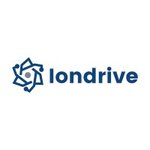ION: Tech to extract critical minerals from old electronic products
Disclosure: S3 Consortium Pty Ltd (the Company) and Associated Entities own 26,785,000 ION shares at the time of publishing this article. The Company has been engaged by ION to share our commentary on the progress of our Investment in ION over time.
Global tensions around securing supply of critical metals are increasing every year.
“Urban mining” is a way for countries to secure critical metals supply from within their own borders...
By extracting critical metals from old, discarded electronic products, like batteries, mobile phones, TVs etc. that would otherwise be headed for the rubbish tip or landfill.
We think Urban Mining is one of the next big investment thematics as the battle for resources intensifies globally and new mines take years to find and develop.
IonDrive (ASX:ION) owns a proprietary technology that delivers cleaner, greener and cheaper recycling than other methods.
It is based on a “Deep Eutectic Solvent” process that can extract critical metals from batteries and old electronics (TVs, mobile phones etc)
Basically this means using biodegradable solutions to dissolve the battery waste materials, leaving behind valuable critical metals.
As it's a solvent process - it means no expensive energy-intensive burning - and no nasty acid-based leaching.
ION is starting by extracting critical metals from old Electric Vehicle batteries.
ION has already proven its battery recycling technology at lab scale.
The next step is to build a pilot plant to prove it can be scaled up - expected this year.
Today ION released early stage economics showing a post tax NPV of $249M.
Which compares pretty favourably to ION’s current market cap...
ION is currently capped at less than $25M, had $4M in the bank at Dec 31st, and will have another $4.5M coming in the coming days via settlement of T2 stock (priced at 1.4c).
After the second tranche of the placement is done ION’s market cap should be somewhere near ~$31M with over $8M cash in the bank.
Why start with recycling EV batteries?
Global EV growth is creating millions of tons of end-of-life batteries each year.
What happens next?
Currently old unwanted batteries get shredded down into a material called ‘black mass’ - where over 80% of it goes to Asia.
That black mass is full of valuable metals like lithium, nickel, cobalt and manganese, which can be extracted and sold back into the market.
By 2040, the volume of end-of-life batteries is projected to generate 11 million tonnes of black mass annually, representing a $100BN recoverable value.
The EU is currently considering a ban on exports of black mass to China, and creating a circular economy for recycling batteries.
ION has a proprietary black mass recycling technology that is cleaner, greener, cheaper recycling than traditional methods.
ION’s is also backed by a team that has a significant amount of experience in the recycling space.
CEO Ebbe Dommisse previously IPO’d a biomass recycling startup in Norway for €194M.
Commercial Director Lewis Utting was MD of an ASX listed wastewater treatment company called SciDev which went from 6.5c to $1.
AND non-exec director Hugo Schumann was the CFO of a private copper processing tech company that was last valued at $2.5BN in 2022.
So the team behind ION knows how to build a recycling tech company from the ground up and attract funding.
Today we got a first look at Pre-feasibility Study (PFS) level economic modelling for a commercial scale recycling plant using ION’s technology.
The financials showed an NPV of $246M, and that the economics are highly sensitive to movements in the prices of battery metals...
So if the prices of metals march onwards and upwards from here, the NPV of ION’s plant goes up.
ION is solving for a current and growing problem
Urban mining is coming and ION is starting by going after the biggest battery market of them all - EV batteries.
ION’s potential breakthrough technology has already shown at lab scale that it can produce very high recoveries of the following metals:
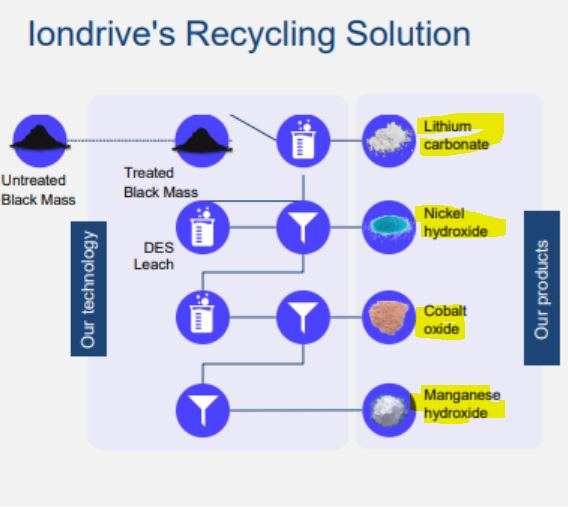
Europe already struggles to get enough critical metals for its battery industry.
(anyone who has ever invested in a small cap company trying to build a mine in Europe will know what we are talking about)
+80% of black mass processing (recycling) occurs in Asia.
After struggling to mine or import the battery metals supply to build their batteries, the EU is then forced to export their old batteries back to Asia to be recycled.
This is very inefficient.
Consequently. Europe is considering export bans on black mass to China...
(and all the precious critical metals inside it)

(Source)
Although it's not an outright export ban (yet), the EU has signaled that it wants to keep as much of the black mass feedstock within its borders as possible.
The Critical Raw Materials Act, which came into effect in May last year, explicitly states that 25% of all critical raw materials consumed inside the EU needs to be recycled by 2030.
At the moment, less than 8.3% of critical raw materials consumed in the EU is recycled.
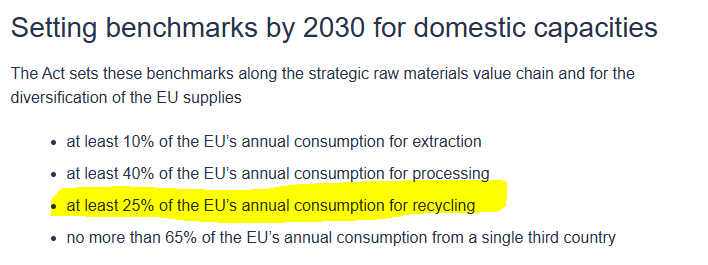
(Source: EU Critical Materials Act)
Within the next 5 years, the EU will need to have new recycling technologies developed and commercialised to meet its goal.
While sentiment for battery metals has been in a low patch, we think that ION as a technology play is the exact kind of counter-cyclical investment that we like to make.
ION’s technology could provide an alternative for Europe - with an elegant solution that suits all parties.
Ultimately, we want to see ION develop and commercialise its tech, this is when we expect to see the biggest uplift in the company’s valuation.
Commercialisation is also central to our Big Bet which is as follows:
Our ION Big Bet:
“ION re-rates to a +$150M market cap on successful large-scale production of commercial quantities of battery materials through its recycling process and/or by securing important partnerships in the recycling industry.”
NOTE: our “Big Bet” is what we HOPE the ultimate success scenario looks like for this particular Investment over the long term (3+ years). There is a lot of work to be done, many risks involved - just some of which we list in our ION Investment Memo. Success will require a significant amount of luck. There is no guarantee that our Big Bet will ever come true.
PFS stage economics released today
Today we got a look at the PFS stage economics of a plant designed to process 21,000 tonnes of raw black mass annually.
This was one of the key objectives we wanted to see ION achieve as part of our ION Investment Memo:
Objective #1: Publish economics on recycling plant projects.
ION is currently undertaking an economic study to evaluate the NPV and IRR of its recycling plant. This will provide us with a much better picture of the potential economic upside of the project.
Milestone
✅ Economic modelling of Net Present Values
Source: 3rd December 2024 ION Investment Memo
The modelling showed a Net Present Value (NPV) of A$246M with an Internal Rate of Return (IRR) of 21%.
Pretty solid metrics for recycling tech play.
The modelling was based on a plant that could process ~21,000 tonnes of black mass into ~10,000 tonnes of “treated black mass” which would be be processed into:
- 4,793 tonnes of Lithium Carbonate
- 3,556 tonnes of Nickel Hydroxide
- 2,603 tonnes of Cobalt Oxide
- 2,335 tonnes of Manganese Oxide
Each of these materials are critical components for lithium-ion batteries.
One of the big things that stood out to us was just how leveraged ION’s recycling tech would be to higher metals prices...
ION economics are highly leveraged to increases in metal prices
Taking a look at the sensitivity analysis on the economic modelling on a proposed plant for ION, we noticed that the biggest impact to NPV numbers comes from metals prices.
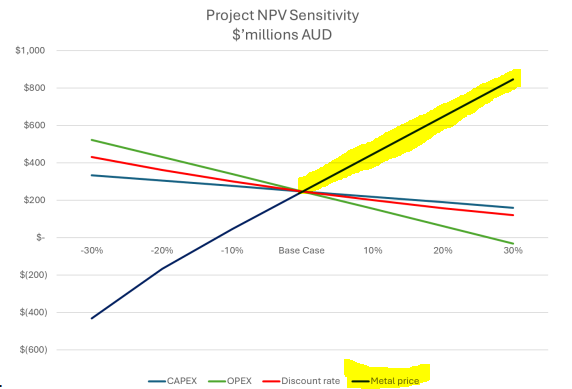
(Source)
This tells us that recycling tech is a way of getting ‘bottom of the market exposure’ to the battery metals space.
When prices are low, the economics of most recycling technologies don’t stack up (which makes sense... it becomes cheaper to mine the stuff out of the ground than it does to recycle).
But when the cycle turns favourably and metals prices rally, returns on recycling tech ramp up exponentially.
We can see that a 30% rise in metals prices (on the base case assumptions ION used) would increase NPV by ~A$800M.
Alternatively, if the assumptions are wrong, even just by 10% then the project is unlikely to be economically viable in its current form.
Below are the pricing assumptions ION used in its modeling:
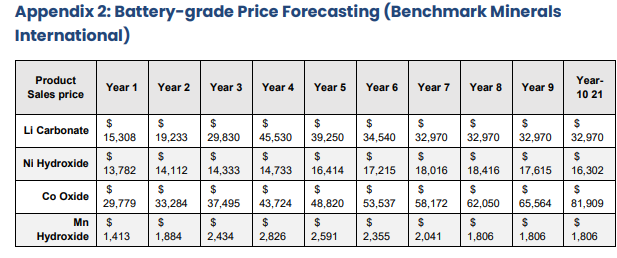
(Source)
It’s incredibly hard to predict where prices will go, but we did notice that most of ION’s revenues from any proposed plant would be from the lithium, nickel and cobalt markets.
As prices in these markets go up, the incentive to bring tech like ION’s to market becomes higher.
As a result these are the key commodity prices we are watching in relation to our ION Investment.
With this economic study published we have added “Commodities Price Risk” to the key risks for ION in our Investment Memo:
Commodity price risk
According to the sensitivity analysis conducted by ION movement in the metals price is the biggest determining factor in the NPV of the project.
If the price of lithium, nickel and cobalt don’t grow as anticipated in the Scoping Study then it could de-value ION’s project.
Valuation uplift on pilot plant?
We Invested in ION because we think it has tech that we think can be developed and commercialised.
AND because we think ION is at an inflection point to where most of the recycling tech companies see the biggest valuation uplift.
Typically, that re-rate happens when the tech comes out of the lab and into a pilot plant.
ION is planning to build its pilot plant by the end of this year (in ~10 months).
In the last ~12 months three private companies working on recycling technology were able to secure big funding deals:
- Ascend Elements raised US$524M and also secured two grants from the US Department of Energy totalling US$480M (September 2023).
- Cylib recently closed a €55M series A round to develop an industrial scale plant (May 2024).
- Descyle also raised €12M in a series A to develop its demonstration plant (November 2024).
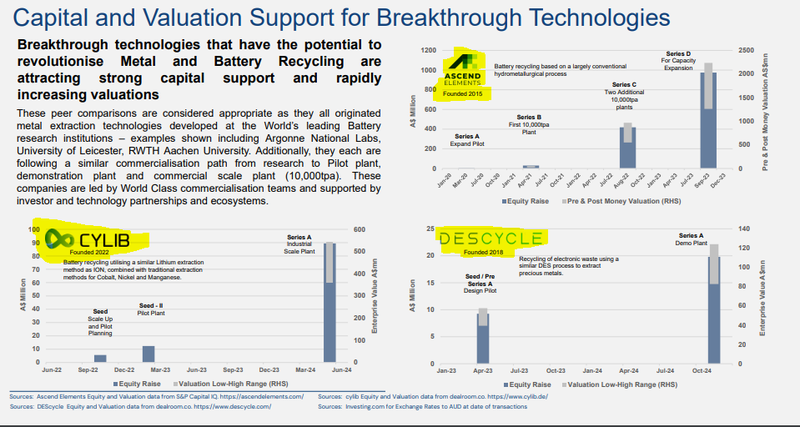
(Source)
ION has already passed the conceptual stage, lab stage and large scale bench trials.
ION right now, is at the stage where it can design and construct its pilot plant.
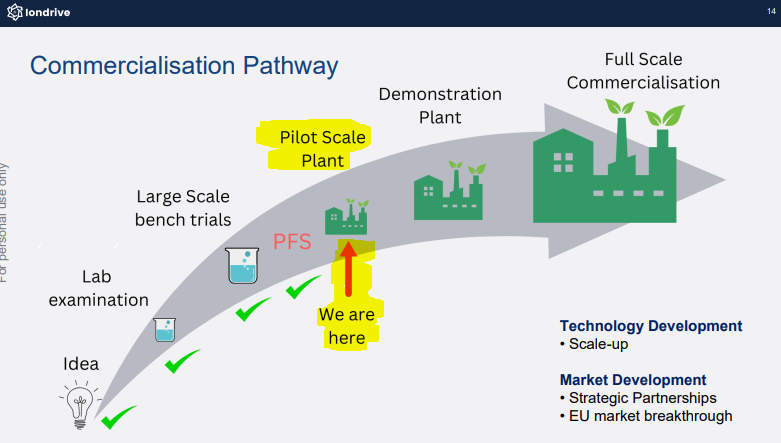
(Source)
We are hoping that ION is able to deliver this pilot plant by the end of the year, and with it, an uplift in its current valuation.
What’s next for ION
Now that we have economic modelling released for a proposed plant we want to see ION complete the design works and start construction of a pilot plant.
Objective #2: Design and build pilot plant
The pilot plant will set the stage for ION to better develop its technology, and provide potential samples to offtake customers.
Milestones
🔲 Complete design of pilot plant
🔲 Lock in EPCM contract for the build
🔲 Start construction on pilot plant
🔲 Complete pilot plant construction
The 12 reasons we Invested in ION
Our reasons for Investing in ION were first published on the 3rd of December 2024 as part of our ION Investment Memo.
Check out that full note here: Our new Investment is Iondrive (ASX: ION)
In our Memo we also detail:
- What ION does
- The macro theme for ION
- Our ION Big Bet
- What we want to see ION achieve
- The key risks to our Investment Thesis
- Our Investment Plan
Below are the 12 key reasons why we are Invested in ION:
1. Solving a current and growing problem.
Electric vehicle growth is creating millions of tons of end-of-life batteries. +80% of battery recycling occurs in Asia. Europe and the USA are already struggling to acquire critical metals and they want to stop exporting their recyclable batteries (and precious battery metals) back to Asia ASAP.
2. Cleaner, greener, cheaper battery recycling process.
ION’s recycling tech uses non-toxic, typically biodegradable Deep Eutectic Solvent (DES). Conventional recycling technologies are much more energy and acid intensive. This means ION’s tech has the potential to be cheaper and more environmentally friendly.
3. Technology proven in large lab trials, now for a Pilot Plant.
ION’s tech has been de-risked in large lab trials with recoveries from pre-treated black mass of 89.1% lithium, 100% nickel, 98.6% cobalt and 98.4% manganese.
The company has published a PFS for a commercial scale 10,000 tonnes per annum plant. ION expects to have a smaller pilot plant operational in 2025 and work towards a commercial scale plant after that.
4. ION’s “Dream Team” that have worked in chemical processing across technology scale up, capital markets and commercial execution.
5. Big money is backing recycling tech.
We have seen a few big deals for recycling technology companies in the last 12 months:
- Ascend Elements raised US$524M and also secured a $480M grant from the US Department of Energy (September 2023).
- Cylib recently raised €55M in what was the biggest recycling tech deal in the EU. The company had only been operational for 2 years before that deal... (May 2024).
- Descyle also raised €12M with backing from some high profile EU venture funds (November 2024).
6. Bottom of cycle pick-up in a strong macro thematic for the future.
Battery metals prices have come off from the 2021-2022 boom years for a number of reasons.
We see this as a counter-cyclical Investment with a relatively cheap entry point as a bet on battery metals prices running again. We expect to see demand for commercially viable recycling technology increase as battery metals prices increase.
7. The EU targets recycling and moves to ban black mass export to China.
The EU has legislated a goal that 15% of critical raw materials consumption comes from recycled content each year. The EU is making moves to classify black mass as a hazardous material in a move to limit China’s ability to import it. This could improve ION’s ability to source feedstock with Europe without being undercut by Chinese competition.
8. ION has joined a battery recycling value chain consortium in the EU.
ION has key industry partnerships within the EU including universities and industry groups. This will set the foundation for critical relationships that ION will need to build to (1) secure a reliable supply of feedstock (black mass) for its processing plant and (2) support with off-take agreements.
9. Tightly held stock and a small valuation, EV of just $7M.
Post money the company will have a cash balance of ~$9M and an enterprise value of ~$7M. The two biggest holders together own close to 40% of the company. Per the last annual report, more than 66% of the stock was held by top 20 shareholders. The largest shareholders appear to hold for the long term, and have supported past cap raises and the most recent raise. Sticky, large, supportive long term holders are very important for a small stock to succeed.
10. VUL success with innovative, clean European battery metals and tech story.
We have seen creative, clean, green tech solutions in battery metals supply work very well with our best ever Investment Vulcan Energy Resources. VUL is still up by over ~30x from our Initial Entry Price and has been rising over the last few months. The EU likes clean battery tech stories and it seems the market does too.
11. Innovation pipeline - more types of recycling tech for different critical metals.
ION has a strategic partnership with the University of Adelaide. ION will get first look at any new technologies developed under a $5M grant by the Australian Research Council which is overseen by the two professors that developed ION’s current DES recycling technology.
12. $100B battery recycling market by 2040.
By 2040 the volume of “end of life” battery projects is expected to generate 11M tonnes of black mass every year. This represents $100BN in recoverable value if it is able to be efficiently recycled. This resolves the “feedstock” issue for both ION and Europe to deliver a battery metals industry.
What are the key risks?
Scale up / technology risk
There is no guarantee that the Pilot Plant is able to replicate the results from the large lab study. Also “feedstock reliability” both in terms of supply and consistency of material is a big risk for ION to scale up its operations.
Commodity price risk
According to the sensitivity analysis conducted by ION movement in the metals price is the biggest determining factor in the NPV of the project.
If the price of lithium, nickel and cobalt don’t grow as anticipated in the Scoping Study then it could de-value ION’s project.
General Information Only
This material has been prepared by StocksDigital. StocksDigital is an authorised representative (CAR 000433913) of 62 Consulting Pty Limited (ABN 88 664 809 303) (AFSL 548573).
This material is general advice only and is not an offer for the purchase or sale of any financial product or service. The material is not intended to provide you with personal financial or tax advice and does not take into account your personal objectives, financial situation or needs. Although we believe that the material is correct, no warranty of accuracy, reliability or completeness is given, except for liability under statute which cannot be excluded. Please note that past performance may not be indicative of future performance and that no guarantee of performance, the return of capital or a particular rate of return is given by 62C, StocksDigital, any of their related body corporates or any other person. To the maximum extent possible, 62C, StocksDigital, their related body corporates or any other person do not accept any liability for any statement in this material.
Conflicts of Interest Notice
S3 and its associated entities may hold investments in companies featured in its articles, including through being paid in the securities of the companies we provide commentary on. We disclose the securities held in relation to a particular company that we provide commentary on. Refer to our Disclosure Policy for information on our self-imposed trading blackouts, hold conditions and de-risking (sell conditions) which seek to mitigate against any potential conflicts of interest.
Publication Notice and Disclaimer
The information contained in this article is current as at the publication date. At the time of publishing, the information contained in this article is based on sources which are available in the public domain that we consider to be reliable, and our own analysis of those sources. The views of the author may not reflect the views of the AFSL holder. Any decision by you to purchase securities in the companies featured in this article should be done so after you have sought your own independent professional advice regarding this information and made your own inquiries as to the validity of any information in this article.
Any forward-looking statements contained in this article are not guarantees or predictions of future performance, and involve known and unknown risks, uncertainties and other factors, many of which are beyond our control, and which may cause actual results or performance of companies featured to differ materially from those expressed in the statements contained in this article. S3 cannot and does not give any assurance that the results or performance expressed or implied by any forward-looking statements contained in this article will actually occur and readers are cautioned not to put undue reliance on forward-looking statements.
This article may include references to our past investing performance. Past performance is not a reliable indicator of our future investing performance.

